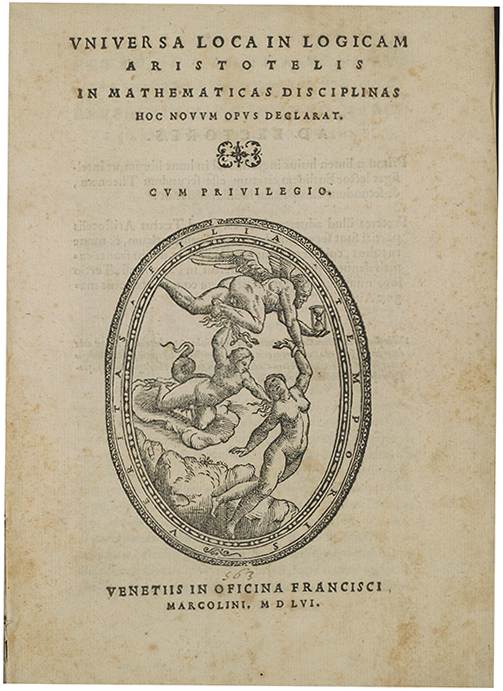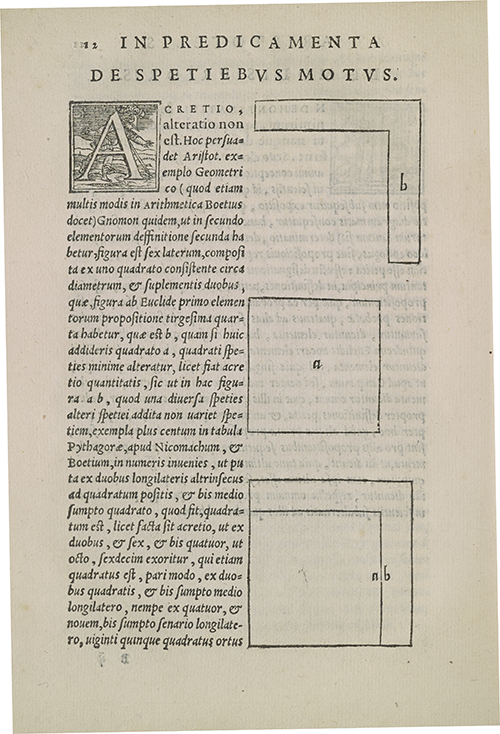- About MAA
- Membership
- MAA Publications
- Periodicals
- Blogs
- MAA Book Series
- MAA Press (an imprint of the AMS)
- MAA Notes
- MAA Reviews
- Mathematical Communication
- Information for Libraries
- Author Resources
- Advertise with MAA
- Meetings
- Competitions
- Programs
- Communities
- MAA Sections
- SIGMAA
- MAA Connect
- Students
- MAA Awards
- Awards Booklets
- Writing Awards
- Teaching Awards
- Service Awards
- Research Awards
- Lecture Awards
- Putnam Competition Individual and Team Winners
- D. E. Shaw Group AMC 8 Awards & Certificates
- Maryam Mirzakhani AMC 10 A Awards & Certificates
- Two Sigma AMC 10 B Awards & Certificates
- Jane Street AMC 12 A Awards & Certificates
- Akamai AMC 12 B Awards & Certificates
- High School Teachers
- News
You are here
Mathematical Treasure: Aristotelian Logic in Arithmetic
Pietro Catena (1501-1576) was an Italian mathematician who taught mathematics at the University of Padua from 1548 until the time of his death. In his Universa loca in logicam Aristotelis, published in Venice in 1556, he attempted to demonstrate the use of Aristotelian logic in mathematics.

Figure 1. Title page of Pietro Catena's Universa loca in logicam Aristotelis

Figure 2. Catena began his consideration of (positive) even integers and square integers.
On page 12 (see Figure 2, above), Catena referred to Boethius, Nicomachus, Euclid, Pythagoras and Aristotle. He then went on to explore Aristotle’s Predicamenta (Categories), employing geo-algebraic demonstrations involving a geometric gnomon and square. In the theory of figurate numbers, a gnomon configuration usually depicted odd numbers, and a square configuration, even numbers as well as square numbers.

Figure 3. Catena continued his discussion of even, odd, and square integers.
On page 13 (see Figure 3, above), considering the small squares bounded by four points as a unit, Catena demonstrated that for a given number (positive integer), \(n:\)
\[n^2 = {(n – 1)}^2 +2(n -1) + 1.\]
Again considering the small squares bounded by four points as a unit, the given gnomon represents the number 9 and the small square 16. In the number theoretic situations of this time, a gnomon added to a square produced a square. On page 13, Catena also mentioned that for \(n\) an even number:
\[n^2 = {(n – 2)}^2 +4(n -2) + 4,\]
which can be seen in the diagrams by considering the points as units. Does this also work when \(n\) is odd? Of course it does, and Catena went on to demonstrate this, representing \(9 + 16 = 25.\)

Figure 4. Catena's consideration of parallel lines
On page 18 (see Figure 4), the author considered the geometric concept of parallel lines. The heading at the top of the section can be translated literally as “things we cannot control.”
Acknowledgments
Assistance with Latin translation was rendered by Barnabas Hughes, OFM.
The images above are presented through the courtesy of the University of California Libraries. A complete digital copy can be read on the Internet Archive.
Reference
To learn more about Pietro Catena, see the article by Giulio Cesare Giacobbe in Dizionario Biografico degli Italiani, Volume 22 (1979), available at http://www.treccani.it/enciclopedia/pietro-catena_(Dizionario_Biografico)/. L’Enciclopedia Italiana is available at www.treccani.it.
Frank J. Swetz (The Pennsylvania State University), "Mathematical Treasure: Aristotelian Logic in Arithmetic," Convergence (October 2015)




